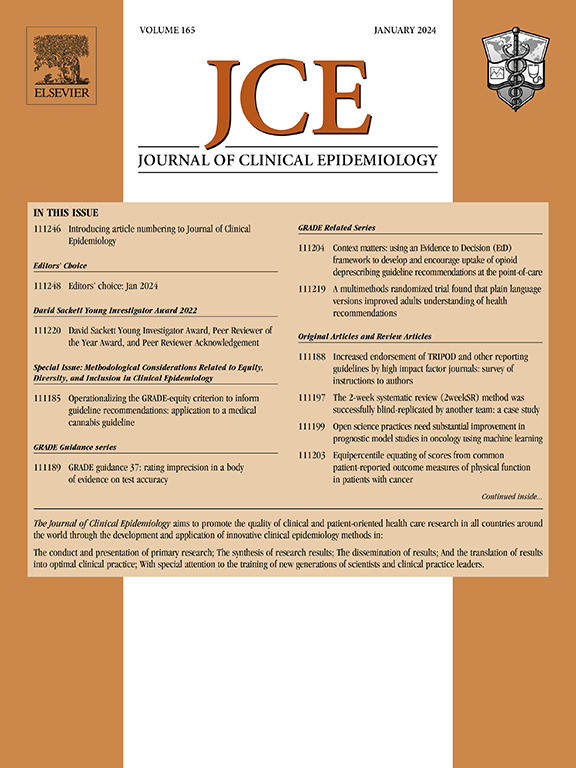A microsimulation model based on healthcare pathways to estimate the impact of COVID-19 pandemic–induced delays on breast cancer mortality
IF 5.2
2区 医学
Q1 HEALTH CARE SCIENCES & SERVICES
引用次数: 0
Abstract
Objectives
This study aimed to develop a microsimulation model to estimate the impact of a care disruption during the COVID-19 pandemic on breast cancer mortality using an administrative database.
Study Design and Setting
Patient flows and pathways were assessed from the French hospital discharge database for four French cancer centers for patients with breast cancer from 2018 to 2021. Patients' return dynamics were compared to time series predictions to determine flow differences. Forecasted and observed patients were matched through healthcare pathways to account for possible delay heterogeneity among patients with breast cancer. Healthcare pathways were modeled and analyzed as sequences of states defined based on hospital treatments. Unmatched patients were reconsidered for matching the next month, with incrementing delays. We derived the number of expected additional cancer deaths at 5 years and the associated relative mortality rate using hazard ratios (HRs) associated with delays extracted from the literature. A deterministic sensitivity analysis was performed on HRs. Confidence intervals were computed for each outcome based on 1000 bootstrap replications.
Results
A forecasted population of 8125 patients with incident breast cancer was analyzed. An overall decrease of 20.8% in flows was estimated during the first lockdown. For the year following the beginning of the lockdown, 24.8% of patients were expected to receive delayed care, resulting in a 4.6% excess cancer mortality rate at 5 years among the 8125 forecasted patients.
Conclusion
Using an innovative approach based on patient-level data from an administrative database, our study further strengthens previous estimates of excess breast cancer mortality following the COVID-19 pandemic.
基于医疗路径的微观模拟模型,评估COVID-19大流行导致的延迟对乳腺癌死亡率的影响。
目的:建立微观模拟模型,利用管理数据库估计COVID-19大流行期间护理中断对乳腺癌死亡率的影响。研究设计:从2018年至2021年法国4家法国癌症中心的乳腺癌患者出院数据库中评估患者流量和路径。将患者返回动态与时间序列预测进行比较,以确定流量差异。预测和观察的患者通过医疗途径匹配,以解释乳腺癌患者可能的延迟异质性。医疗保健路径建模和分析为基于医院治疗定义的状态序列。未匹配的患者被重新考虑下个月进行匹配,并逐渐推迟。我们使用从文献中提取的与延迟相关的风险比(hr),推导出5年预期额外癌症死亡人数和相关的相对死亡率。对hr进行确定性敏感性分析。每个结果的置信区间是基于1000次自举重复来计算的。结果:对8125例乳腺癌患者的预测人群进行分析。据估计,在第一次封城期间,流量总体下降了20.8%。在封锁开始后的一年里,预计24.8%的患者将接受延迟治疗,导致在预测的8125名患者中,5年癌症死亡率高出4.6%。结论:我们的研究采用了一种基于行政数据库中患者层面数据的创新方法,进一步加强了之前对COVID-19大流行后乳腺癌死亡率过高的估计。
本文章由计算机程序翻译,如有差异,请以英文原文为准。
求助全文
约1分钟内获得全文
求助全文
来源期刊

Journal of Clinical Epidemiology
医学-公共卫生、环境卫生与职业卫生
CiteScore
12.00
自引率
6.90%
发文量
320
审稿时长
44 days
期刊介绍:
The Journal of Clinical Epidemiology strives to enhance the quality of clinical and patient-oriented healthcare research by advancing and applying innovative methods in conducting, presenting, synthesizing, disseminating, and translating research results into optimal clinical practice. Special emphasis is placed on training new generations of scientists and clinical practice leaders.
 求助内容:
求助内容: 应助结果提醒方式:
应助结果提醒方式:


